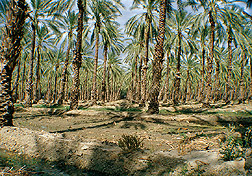Dates Go Under Cover
|
|
|
Dates—those sweet, chewy, fiber-packed fruits—may be making a comeback in California, thanks to sustainable agricultural practices that have improved soil quality. In recent years, growers began noticing a decline in date fruit quality and suspected it was because the trees were aging. Looking for help, growers called ARS plant physiologist Aref Abdul-Baki. He discovered that it wasn't the trees that needed help, but the soil. Abdul-Baki, with ARS' Vegetable Laboratory in Beltsville, Maryland, has been active in helping vegetable growers learn about the value of sustainable cover crops. He's shown them how to improve crop yields and reduce production costs by adopting a system in which cover crops improve soil quality by adding organic matter, fixing nitrogen, and recycling nutrients. Although vegetable growers are evaluating his system, it hasn't been used in date orchards. |
|
|
In 1997, he and date growers teamed up on a study in California's Coachella Valley in collaboration with USDA's Natural Resources Conservation Service and the California Date Commission. "Farmers thought old trees were the reason for declining fruit quality, but some 60-year-old trees are still very productive," says Abdul-Baki. He adds, "Our results from an extensive soil profile study of date orchards, covering about 1,400 acres, reveal many orchards are suffering from poor nutrition and compacted soil. Soil compaction prevents roots from pushing down deep into the soil profile. Roots are unable to get the amount of water and nutrients they need." Growers are working to correct this problem by adopting Abdul-Baki's no-tillage system. They planted two legume cover crops—Lana vetch and Clay Iron cowpeas. Lana vetch is planted in the fall and reseeds itself. The cowpea crop is grown in the spring and must be reseeded each year. Both cover crops fix a lot of nitrogen and produce high yields of biomass that serve as organic matter to enrich the soil. Abdul-Baki says this no-tillage system reduces cultivation and production costs, loosens compacted soils, adds organic matter, recycles nutrients, and reduces soil temperature. High soil temperature stresses roots, he explains. All is going well in the study thus far, but it takes about 5 years to see the full benefits of a sustainable no-tillage system, Abdul-Baki points out. "We've changed the way we manage our soils and have improved fertilizer use," says Albert P. Keck, vice chair of the California Date Commission in Indio, California. "We know significant changes take time. So far, we're pleased and are hoping these orchards will bear more fruit in the future." As a result of Abdul-Baki's work in California, about 5,000 acres in the Coachella Valley are incorporating cover crops into vegetable and fruit production. About 90 percent of U.S. dates come from California; the rest are produced in Arizona. The industry is small. Annual production is about 24,000 tons and is valued at about $62 million annually. The research could help growers stay competitive—particularly with foreign date producers.—By Tara Weaver-Missick, Agricultural Research Service Information Staff. This research is part of Crop Production, an ARS National Program (#305) described on the World Wide Web at http://www.nps.ars.usda.gov/programs/cppvs.htm. Aref Abdul-Baki is located at the USDA-ARS Vegetable Laboratory, Bldg. 10A, 10300 Baltimore Blvd., Beltsville, MD 20705-2350; phone (301) 504-5057, fax (301) 504-5555. |
|
"Dates Go Under Cover" was published in the January 2000 issue of Agricultural Research magazine.
|
|








